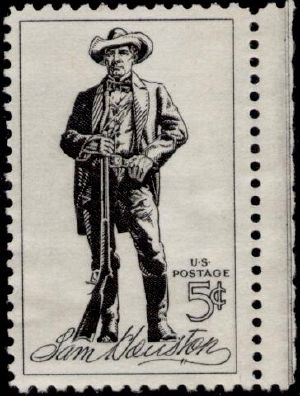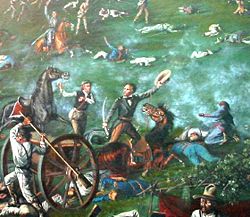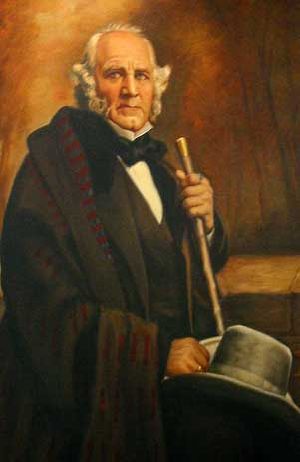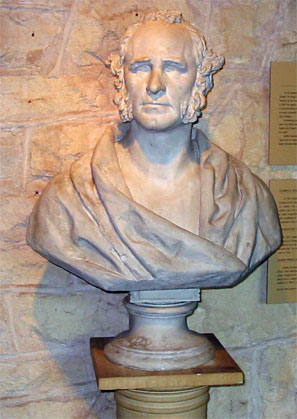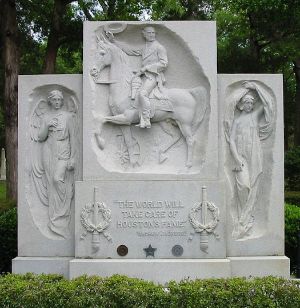Difference between revisions of "Sam Houston" - New World Encyclopedia
(imported article and wiki version credit) |
({{Contracted}}) |
||
| Line 1: | Line 1: | ||
| + | {{Contracted}} | ||
{{Otherpeople|Sam Houston}} | {{Otherpeople|Sam Houston}} | ||
{{Infobox Governor | {{Infobox Governor | ||
Revision as of 15:08, 5 April 2007
- For other persons named Sam Houston, see Sam Houston (disambiguation).
| Sam Houston | |
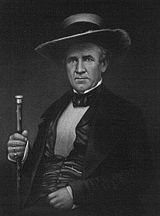
| |
7th Governor of Tennessee
| |
| In office 1827 – 1829 | |
| Lieutenant(s) | William Hall |
|---|---|
| Preceded by | William Carroll |
| Succeeded by | William Hall |
7th Governor of Texas
| |
| In office 1859 – 1861 | |
| Preceded by | Hardin Richard Runnels |
| Succeeded by | Edward Clark |
| Born | March 2, 1793 Rockbridge County, Virginia |
| Died | July 26, 1863 Huntsville, Texas |
| Spouse | Eliza Allen
Tiana Rogers Gentry Margaret Moffette Lea |
| Religion | Baptist |
Samuel Houston (March 2, 1793–July 26, 1863) was a 19th century American statesman, politician and soldier. The Virginia-born Houston was a key figure in the history of Texas, including periods as President of the Republic of Texas, Senator for Texas after it joined the Union, and finally as governor. Although a slaveowner and opponent of abolitionism, his unionist convictions meant he refused to swear loyalty to the Confederacy when Texas seceded from the Union, bringing his governorship to an end. To avoid bloodshed, he refused an offer of an army to put down the rebellion, and instead retired to Huntsville, Texas, where he died before the end of the Civil War.
His earlier life included encouraging emigration to Tennessee, time spent with the Cherokee Nation (into which he was adopted and later married into), military service in the War of 1812, and subsequent successful involvement in Tennessee politics. Indeed, as of 2007, Houston has been the only person in U.S. history to have been the governor of two different states, Tennessee and Texas (although others have been governors of multiple American colonies). A fight with a Congressman, followed by a high profile trial, led to his emigration to Mexican Texas, where he soon became a leader of the Texas Revolution. He supported annexation by the United States rather than seeking long term independence and expansion for Texas. The city of Houston was named after him during this period. Houston's reputation survived his death: posthumous commemoration has included a memorial museum, a U.S. Army base, an historical park, a university, and the largest statue of an American hero.
Biography
Early life
Houston was born on his family's plantation near Timber Ridge Church, outside Lexington, Virginia in Rockbridge County, to Major Samuel Houston and Elizabeth Paxton and was one of nine children. His father was a member of Morgan's Rifle Brigade during the American Revolutionary War.
Receiving only a basic education, he immigrated with his family to Maryville, Tennessee following the death of his father in 1807. His mother then took the family to live on Baker Creek, Tennessee. He ran away from home in 1809 and resided for a time with the Cherokee tribe of Chief Oolooteka on Hiwassee Island. He was adopted into the Cherokee Nation and given the name Colleneh or "the Raven". He returned to Maryville in 1812 at the age of 19 and founded a one-room schoolhouse. This was the first school ever built in Tennessee, which had become a state in 1796.
War of 1812

In 1812 Houston enlisted into the 7th Regiment of Infantry to fight the British in the War of 1812. By December of that year, he had risen from private to third lieutenant. At the Battle of Horseshoe Bend in March 1814 he was wounded by a Creek arrow. His wound was bandaged, and he rejoined the fight. When Andrew Jackson called on volunteers to dislodge a group of Red Sticks (Creek Indians) from their breastworks (fortifications), Houston volunteered, but during the assault was struck by a bullet in the shoulder and arm. Houston became close to Jackson, even joining Jackson's Masonic lodge, Cumberland Lodge No. 8, in 1817. Following his recovery he was assigned as an Indian agent to the Cherokees. He left the army in March 1818.
Tennessee politics
Following six months of study, he opened a legal practice in Lebanon, Tennessee.[1] He was made attorney general of the Nashville district in late 1818 and was also given a command in the state militia. In 1822 he was elected to the House of Representatives for Tennessee, where he was a staunch supporter of fellow Tennessean and Democrat Andrew Jackson and was widely considered to be Jackson's political protégé though their treatment of Indians differed greatly. He was a congressman from 1823 to 1827. He was re-elected in 1824. In 1827 he declined to run for re-election to Congress and instead ran for, and won, the office of governor of Tennessee, defeating the former governor, Willie Blount. He planned to stand for re-election in 1828, but resigned after marrying eighteen year old Eliza Allen. The marriage was forced by Allen's father, Colonel John Allen, and never blossomed into a relationship. Houston and Allen separated shortly after the marriage, when Houston accused his wife of infidelity, and divorced in 1837, after he became President of Texas.
He spent time among the Cherokee, married a Cherokee widow named Tiana Rogers Gentry, and set up a trading post (Wigwam Neosho near Fort Gibson, Cherokee Nation), apparently drinking heavily the entire time. His alleged drunkenness and abandonment of his office and wife caused a rift with his mentor Andrew Jackson, which would not be healed for several years.
Controversy and trial
On a trip to New York and Washington, D.C. on business, Houston became embroiled in a fight with an anti-Jacksonian Congressman. While Houston was in Washington in April 1832, Congressman William Stanbery of Ohio made accusations about Houston in a speech on the floor of Congress. Stanbery was attacking Jackson through Houston and accused Houston of being in league with John Von Fossen and Congressman Robert Rose.
The three men bid on the supplying of rations to immigrating Indians due to Jackson's Indian Removal Act of 1830. Stanbery, now carrying two pistols and a dirk, refused to answer Houston's letters; infuriated, Houston later confronted Stanbery on Pennsylvania Avenue as he left Mrs. Queen's boardinghouse and proceeded to beat him with a hickory cane. Stanbery did manage to pull one of his pistols, place it at Houston's chest and pull the trigger—the gun misfired.
On April 17 Congress ordered the arrest of Houston, who pleaded self-defense, and hired Francis Scott Key as his lawyer. Houston was found guilty in the high profile trial, but thanks to high placed friends (among them James K. Polk), he was only lightly reprimanded. Stanbery then filed charges against Houston in civil court. Judge William Cranch found Houston liable and fined him $500, a fine he never paid before leaving the country.
Texas
The publicity surrounding the trial resurrected Houston's political reputation, and he left the Cherokee and his wife, Diana Rodgers, also known as Tiana Rodgers, to enter Mexican Texas in December 1832. Houston had asked his wife, Tiana, to accompany him to Texas, but she wanted to settle down and preferred to stay at the log cabin and trading post. Tiana later remarried a man named Sam McGrady, but died of pneumonia in 1838. Houston did not remarry until after her death. After reaching Mexican Texas he was immediately swept up in the politics of the Mexican state. There has been speculation over the years that Houston went to Texas at the behest of President Andrew Jackson to seek the annexation of the territory for the United States.
Houston attended the Convention of 1833 as representative for Nacogdoches and emerged as a supporter of William Harris Wharton and his brother who supported complete independence from Mexico, the more radical stance of those represented. He also attended the Consultation of 1835. He was made a Major General, of the Texas Army in November 1835, then Commander-in-Chief in March 1836. He negotiated a settlement with the Cherokee in February 1836.
Republic of Texas
Following the Texas Declaration of Independence on March 2, 1836, Houston joined his volunteer army at Gonzales, but was soon forced to retreat in the face of the forces of Mexican General and dictator Antonio López de Santa Anna, whose army killed all those at The Alamo Mission during the Battle of the Alamo on March 6.
At the Battle of San Jacinto on April 21, 1836, however, Houston suprised Santa Anna and the Mexican forces during their afternoon siesta. Badly beaten, Santa Anna was forced to sign the Treaty of Velasco, granting Texas independence. Although Houston stayed on briefly for negotiations, he returned to the United States for treatment of a wound to his ankle.
Using his popularity, Houston was twice elected president of the Republic of Texas (the first time on September 5, 1836). He served from October 22, 1836, to December 10, 1838, and again from December 12, 1841 to December 9, 1844. On December 20, 1837, Houston presided over the convention of Freemasons that formed the Grand Lodge of the Republic of Texas, now the Grand Lodge of Texas.
He put down the Cordova Rebellion of 1838 and while initially seeking annexation by the U.S. he dropped that hope during his first term. In his second term, he strove for financial prudence and worked to make peace with the Indians and avoid war with Mexico, following the two invasions of 1842. He had to act over the Regulator-Moderator War of 1844 and sent in the militia.
Settlement of Houston
The settlement of Houston was founded in August 1836 by brothers J.K. Allen and A.C. Allen and named in Houston's honor and served as capital. Gail Borden helped lay out Houston's streets.
The city of Houston served as the capital until President Mirabeau Lamar signed a measure moving the capital to Austin on January 14, 1839. Between his presidential terms (the constitution did not allow a president to serve consecutive terms), he was a representative in the Texas House of Representatives for San Augustine. He was a major critic of President Mirabeau Lamar, who advocated continuing independence of Texas and its extension to the Pacific Ocean.
Marriage
On May 9, 1840, in Marion, Alabama, Houston married Margaret Moffette Lea, with whom he had eight children. He was 47 and she was 21. Margaret acted as a tempering influence on Houston. Although the Houstons had numerous houses, only one was kept continuously, Cedar Point, on Trinity Bay from ca. 1840 through 1863.
U.S. Senator
After the annexation of Texas by the United States in 1845, he was elected to the U.S. Senate along with Thomas Jefferson Rusk. Houston served there from February 21, 1846, until March 4, 1859. He was a Senator during the Mexican-American War, when the U.S. acquired from Mexico vast new territory in the Southwest.
Throughout his term in the Senate, Houston spoke out against the growing sectionalism of the country, and blamed the extremists of both the North and South, saying: "Whatever is calculated to weaken or impair the strength of [the] Union, — whether originating at the North or the South, — whether arising from the incendiary violence of abolitionists, or from the coalition of nullifiers, will never meet with my unqualified approval."
Houston supported the Oregon Bill in 1848, which was opposed by many Southerners. In his passionate speech in support of the Compromise of 1850, Houston said "A nation divided against itself cannot stand". Eight years later, Abraham Lincoln would express a similar sentiment.
Houston opposed the Kansas-Nebraska Act in 1854, and correctly predicted that it would cause a sectional rift in the country that would eventually lead to war: "…what fields of blood, what scenes of horror, what mighty cities in smoke and ruins — it is brother murdering brother… I see my beloved South go down in the unequal contest, in a sea of blood and smoking ruin." He was considered a potential candidate for president. But, despite the fact that he was a slave-owner, his strong Unionism and opposition to the extension of slavery alienated the Texas legislature and other southern States.
Governor of Texas
He twice ran for governor of Texas, unsuccessfully in 1857 and successfully against Hardin R. Runnels in 1859 as a Unionist, making him the only person in U.S. history to be the governor of two different states. Despite Houston's being a slave owner and against abolition, he opposed the secession of Texas from the Union. In 1860, he offered the following prediction: "Let me tell you what is coming. After the sacrifice of countless millions of treasure and hundreds of thousands of lives you may win Southern independence, but I doubt it. The North is determined to preserve this Union."[2]
Notwithstanding Houston's wishes, Texas seceded from the United States on February 1, 1861, and joined the Confederate States of America March 2, 1861. The political forces that brought about Texas's secession also were powerful enough to replace her Unionist governor. Houston chose not to resist, stating that, "I love Texas too well to bring civil strife and bloodshed upon her. To avert this calamity, I shall make no endeavor to maintain my authority as Chief Executive of this State, except by the peaceful exercise of my functions...." He was evicted from his office on March 16, 1861, for refusing to take an oath of loyalty to the Confederacy, writing
"Fellow-Citizens, in the name of your rights and liberties, which I believe have been trampled upon, I refuse to take this oath. In the name of the nationality of Texas, which has been betrayed by the Convention, I refuse to take this oath. In the name of the Constitution of Texas, I refuse to take this oath. In the name of my own conscience and manhood, which this Convention would degrade by dragging me before it, to pander to the malice of my enemies....I refuse to take this oath."
He was replaced by Lieutenant Governor Edward Clark. To avoid more bloodshed in Texas, Houston turned down U.S. Col. Frederick W. Lander's offer from President Lincoln of 50,000 troops to prevent Texas's secession, stating in his response, "Allow me to most respectfully decline any such assistance of the United States Government."
Final years
In 1854, Houston, having earlier made a profession of Christian faith, was baptized by the Baptist minister, Rufus C. Burleson, who was later the president of Baylor University, then Baylor College. At the time Burleson was the pastor of the Independence, Texas, Baptist Church in Washington County, which Houston and his wife attended. Houston was also a close friend of another Baylor president and Burleson's predecessor as pastor at the Independence church, the Reverend George Washington Baines, maternal great-grandfather of Lyndon B. Johnson.
In 1862, Houston retired to his farm in Huntsville, Texas, because the hills there reminded him of his boyhood home near Maryville, Tennessee. His health deteriorated quickly over the next few months as he developed a persistent cough. In mid-July, Houston was struck with a severe chill which progressed into pneumonia. Despite the efforts of Drs. Markham and Kittrell, on July 26, 1863, at 6:16 p.m, Houston died quietly in his Steamboat House with his wife Margaret by his side. His last recorded words were "Texas. Texas. Margaret". The inscription on his tomb reads:
- A Brave Soldier. A Fearless Statesman.
- A Great Orator — A Pure Patriot.
- A Faithful Friend, A Loyal Citizen.
- A Devoted Husband and Father.
- A Consistent Christian — An Honest Man.
While Sam Houston is buried in Huntsville, Texas, his wife Margaret Lea is buried in the City of Independence, Texas.
Monuments and museums
- Huntsville, Texas, is the home of the Sam Houston Memorial Museum, a 69 ft statue, Sam Houston State University, and Houston's gravesite. The statue (which is the world's largest statue of an American hero, easily visible by motorists traveling on Interstate 45) is the title and subject of a country music song by Merle Haggard.
- A bronze equestrian sculpture of Houston is located in Hermann Park in Houston, Texas.
- The Sam Houston Wayside near Lexington, Virginia, is a 38,000-pound piece of Texas pink granite commemorating Houston's birthplace.
- The Sam Houston Schoolhouse in Maryville, Tennessee, is Tennessee's oldest schoolhouse. In addition to the schoolhouse there is a museum on the grounds.
- USS Sam Houston, a Ethan Allen class submarine, was named after Houston.
- The Sam Houston National Forest, one of four national forests in Texas, was named after Houston. [1]
- The Sam Houston Regional Library and Research Center, located outside of Liberty, Texas has the largest known collection of photographs and illustrations of Houston.
- Fort Sam Houston in San Antonio, Texas, is named after Houston.
- Many cities in the U.S. have a street, school, or park named for Houston.
Children
By Margaret Lea
- Sam Houston, Jr., 1843-1894
- Nancy Elizabeth, 1846-1920
- Margaret Lea, 1848-1906
- Mary William, 1850-1931
- Antoinette Power, 1852-1932
- Andrew Jackson Houston, 1854-1941
- William Rogers Houston, 1858-1880s?
- Temple Lea Houston, 1860-1905
Popular culture
Houston has been a character in a number of movies. The best known is probably "The First Texan," in which he was played by Joel McCrea. Richard Boone played Houston in the 1960 movie The Alamo. In the 1986 CBS TV movie Gone to Texas: The Sam Houston Story, he was played by Sam Elliott. He makes a brief appearance in the 1987 television movie Alamo: Thirteen Days to Glory, portrayed by Lorne Greene. In the 2004 film, The Alamo, Houston was portrayed by Dennis Quaid.
He also appears in the alternative history novel, 1812: The Rivers of War, by Eric Flint. He distinguishes himself at the Battle of Horseshoe Bend during the War of 1812 and is not seriously wounded. Sent to Washington, D.C., by General Andrew Jackson, he arrives in time to rally fleeing American forces and repels the British invasion of Washington. He later leads an expedition to reinforce Jackson and fights at the Battle of New Orleans. Flint, in his Afterword, refers to the novel "as an alternate biography of Sam Houston."
Notes
- ↑ Lebanon, Tennessee: A Tour of Our City (PDF). Lebanon/Wilson County Chamber of Commerce. Retrieved February 5, 2007.
- ↑ James, Marquis. The Raven. Dunwoody, Georgia: Norman S. Berg, Publisher, by arrangement with Bobbs-Merrill Co., 1929.. Retrieved March 5, 2007.
ReferencesISBN links support NWE through referral fees
The following are reference sources (alphabetical by author):
- Andrew Jackson-His Life and Times; Brands, H.W.; Doubleday; ISBN 0-385-50738-0.
- The Texas Revolution; Brinkley, William, Texas A&M Press: ISBN 0-87611-041-3.
- Sword of San Jacinto, Marshall De Bruhl, Random House: ISBN 0-394-57623-3.
- Sam Houston, Haley, James L., University of Oklahoma Press: ISBN 0-8061-3644-8.
- The Raven: A Biography of Sam Houston; James, Marquis; University of Texas Press: ISBN 0-292-77040-5.
- The Eagle and the Raven; Michener, James A., State House Press: ISBN 0-938349-57-0.
External links
- Roosevelt and Sam Houston - story about President Roosevelt's experience with Sam Houston
- Congressional biography
- Life of General Houston, 1793-1863 published 1891, hosted by the Portal to Texas History.
- Sam Houston ; David Crockett. published 1901, hosted by the Portal to Texas History.
- Samuel Houston from the Handbook of Texas Online
- Sam Houston Memorial Museum
- Sam Houston Memorial Museum Antiquities Collection From Texas Tides
- Sam Houston's Obituary - The Tri Weekly Telegraph, Houston, Texas July 29, 1863 - TexasBob.com
- Sam Houston Historic Schoolhouse in Maryville, TN USA
| Political offices | ||
|---|---|---|
| Preceded by: Newton Cannon |
U.S. Representative for Tennessee's 4th Congressional District 1823-1825 |
Succeeded by: Jacob C. Isacks |
| Preceded by: William Carroll |
Governor of Tennessee 1827–1829 |
Succeeded by: William Hall |
| Preceded by: David G. Burnet (ad interim) |
President of the Republic of Texas 1836–1838 |
Succeeded by: Mirabeau B. Lamar |
| Preceded by: Mirabeau B. Lamar |
President of the Republic of Texas 1841–1844 |
Succeeded by: Anson Jones |
| Preceded by: None |
United States Senator (Class 2) from Texas 1846–1859 |
Succeeded by: John Hemphill |
| Preceded by: Hardin R. Runnels |
Governor of Texas 1859–1861 |
Succeeded by: Edward Clark |
Credits
New World Encyclopedia writers and editors rewrote and completed the Wikipedia article in accordance with New World Encyclopedia standards. This article abides by terms of the Creative Commons CC-by-sa 3.0 License (CC-by-sa), which may be used and disseminated with proper attribution. Credit is due under the terms of this license that can reference both the New World Encyclopedia contributors and the selfless volunteer contributors of the Wikimedia Foundation. To cite this article click here for a list of acceptable citing formats.The history of earlier contributions by wikipedians is accessible to researchers here:
The history of this article since it was imported to New World Encyclopedia:
Note: Some restrictions may apply to use of individual images which are separately licensed.
